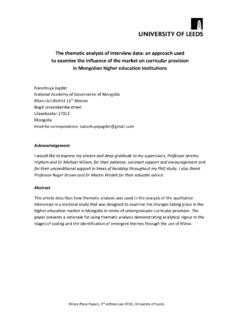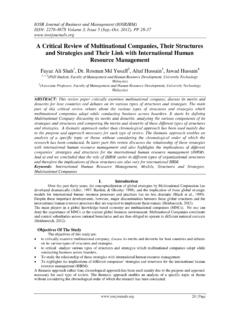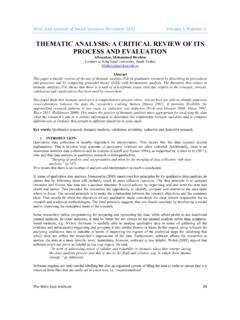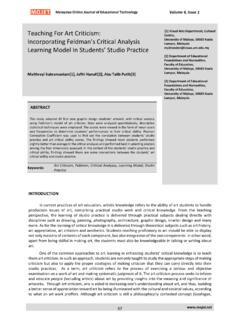Transcription of The thematic analysis of interview data: an approach used ...
1 Hillary Place Papers, 3rd edition (Jan 2016), University of Leeds The thematic analysis of interview data: an approach used to examine the influence of the market on curricular provision in Mongolian higher education institutions Narantuya Jugder National Academy of Governance of Mongolia Khan-Uul district 11th khoroo Bogd Javzandamba street Ulaanbaatar 17012 Mongolia Email for correspondence: Acknowledgement I would like to express my sincere and deep gratitude to my supervisors, Professor Jeremy Higham and Dr Michael Wilson, for their patience, constant support and encouragement and for their unconditional support in times of hardship throughout my PhD study.
2 I also thank Professor Roger Brown and Dr Martin Wedell for their valuable advice. Abstract This article describes how thematic analysis was used in the analysis of the qualitative interviews in a doctoral study that was designed to examine the changes taking place in the higher education market in Mongolia in terms of undergraduate curricular provision. The paper presents a rationale for using thematic analysis demonstrating analytical rigour in the stages of coding and the identification of emergent themes through the use of NVivo. 2 Narantuya Jugder Hillary Place Papers, 3rd edition (Jan 2016), University of Leeds Context of the research According to the 2010-2011 education statistics issued by the Ministry of Education and Science of Mongolia, there were 113 HE institutions for a population of million people.
3 The student population was not large: 155801 students studying at HE institutions for Bachelor degrees. Of all new entrants to HEIs in the 2012 academic year, completed their general education schooling in the same year. The aim of the study was to examine the changes in Mongolian higher education in the context of the market and to assess their influence on institutions of higher education, in particular on curricular provision at undergraduate level. The primary method chosen for this multi-site case study was chosen as interviews to get multiple perspectives, augmented by documentary sources of evidence.
4 A sample of five universities was selected on the basis of both convenience and representation: two of the country s four private universities and three of the eight civil universities, one of which had been selected for a pilot study. The data collection was based on interviews with 50 respondents including both university administrators and decision making officials. In addition, document review was carried out. Why use thematic analysis for this study? Qualitative interviews were the main method in the study to obtain various perspectives on the research questions related to the nature of the changes in curricular provision in the context of the emerging market in Mongolia.
5 Qualitative interviews give a new insight into a social phenomenon as they allow the respondents to reflect and reason on a variety of subjects in a different way (Folkestad, 2008, ). Consequently, conducting interviews with policy makers and educational administrators were seen as an option within many that gives insight into the phenomenon under investigation because key informants - the sampling strategy in the study - are often critical to the success of a case study, as such persons not only provide with insights into a matter but also can suggest sources of corroboratory or contrary evidence (Yin, 1994, ).
6 Since the interviews were the primary technique of the data collection, it was therefore important to be mindful of the kind of the data analysis in the earlier stages. The method of analysis chosen for my study was a qualitative approach of thematic analysis . Generally, thematic analysis is the most widely used qualitative approach to analysing interviews. The conceptual framework of the thematic analysis for my interviews was mainly built upon the theoretical positions of Braun and Clarke (2006). According to them, thematic analysis is a method used for identifying, analysing, and reporting patterns (themes) within the data (2006, ).
7 The reason I chose this method was that rigorous thematic approach can produce an insightful analysis that answers particular research questions (Braun and Clarke, 2006, ). In addition, this approach complemented the research questions by facilitating an investigation of the interview data from two perspectives: first, from a influence of the market on curricular provision in Mongolian higher education institutions 3 Hillary Place Papers, 3rd edition (Jan 2016), University of Leeds driven perspective and a perspective based on coding in an inductive way; second from the research question perspective to check if the data were consistent with the research questions and providing sufficient information.
8 The next important consideration was identifying themes in the interview data I collected. What counts as a theme is that it is something which captures the key idea about the data in relation to the research question and which represents some level of patterned response or meaning within the data set (Braun and Clarke, 2006, ). Here the main requirement is to be consistent throughout the process of determining themes. As Bazeley (2009, ) claims themes only attain full significance when they are linked to form a coordinated picture or an explanatory model: Describe, compare, relate is a simple three-step formula when report the results.
9 As Braun and Clarke (2006) explain themes or patterns within data can be identified either in an inductive 'bottom up' way (citing Frith and Gleeson, 2004), or in a theoretical, deductive 'top down' way (citing Boyatzis, 1998 and Hayes, 1997). According to Thomas (2003, ), the primary purpose of the inductive approach is to allow research findings to emerge from the frequent, dominant or significant themes inherent in raw data, without the restraints imposed by structured methodologies. Thomas (2003) points out three main purposes for using an inductive approach : (1) to condense extensive and varied raw text data into a brief, summary format; (2) to establish clear links between the research objectives and the summary findings derived from the raw data; and (3) to develop a model or theory about the underlying structure of experiences or processes which are evident in the raw data.
10 However, I acknowledge that top-down and bottom-up process are interactive in some way because the research keeps a specific interest in identifying themes influenced by the theoretical framework. Demonstrating rigour using thematic analysis The data collected through interviews with policy makers and higher education administrators were analysed in a similar way based on a three-stage procedure suggested in the literature (Creswell, 2007; Miles & Huberman, 1984): preparing the data for analysis by transcribing, reducing the data into themes through a process of coding and representing the data.





